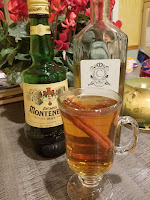Wormwood (Artemisia absinthium) has been used for several millennia in traditional medicine to treat a range of ailments, including digestive issues, fever, and skin problems as the first recorded use of the herb dates back to 1552 B.C. in ancient Egypt. Wormwood is the major ingredient in absinthe which originated in the 18th century in Switzerland when a "French doctor named Dr. Pierre Ordinaire created an all-purpose patent remedy in Couvet, Switzerland around 1792. This remedy was made with a combination of wormwood, anise, and other herbs.
Absinthe gained popularity in the 19th century, particularly in France, where it became known as "la fée verte" or the green fairy. It was often consumed in specialized absinthe bars, where it was served in a unique ritual involving a sugar cube, water, and a slotted spoon. The drink’s popularity became controversy as it was blamed for a range of social ills, including increased crime rates, poverty, and moral decay. In 1912, absinthe was banned in the United States, and it remained illegal until 2007. Similar bans occurred in some Western European countries such as France.

Technically speaking, the government never banned Absinthe but they banned thujone - the chemical compound in wormwood - that sensationalized science at the time theorized caused seizures and hallucinations. In October 2007 the TTB issued new guidelines that made Absinthe containing thujone legal as long as the bottle contained less than 10 parts per million of thujone. In there words, if it contained less than this amount it was considered “thujone free” and was therefore legal.
When France softened their Absinthe ban in 1988, Distilleries Domaines de Provence, was the first company to restart producing absinthe using a 160 year old recipe based on plants growing on the Lure mountain range. This mountain lies between the Alps and the Mediterranean and thus benefits from a unique climate ideal for the development of a diverse array of plants. According to the distillery, "The Alpes de Haute-Provence department is rich with some of the most abundant and varied flora in France, and is no doubt unique in the number of plant and botanical groups to be found there. ”
Distilleries Domaines de Provence's
Absente Absinthe was the first brand released in the U.S. after re-legalization and uses the original 160 year old French recipe which includes the noticeable wormwood but also star and green anise, lemon balm, mugwort, citrus, and peppermint. The traditional and historic method to serve Absente that was popular in the 1800s is to pour a couple of ounces of Absente in a glass, upon which a sugar-cube-topped absinthe spoon is placed. Then, and equal amount of cold water is dripped over the sugar. The water turns the absinthe cloudy -- called
louche -- which allows the flavors of the spirit spring forth.
That being said, cocktails are another satisfying use of absinthe and here are a trio that I tinkered with after receiving the Absente 55° case + Van Gogh spoon. For the De La Louisiane I chose to make it a Cajun-Hungarian recipe honoring the Hungarian immigrants who became loggers around Albany, Louisiana and our friends at Wildcat Brothers Distilling. The distillery just released Cochon Sauvage -- a rhum agricole aged three years in 2nd use rye whiskey barrels (which replaces the rye whiskey) and good ol' Unicum Silva in place of the Bénédictine. And for the Green Cider, I used the Lonetree Cider Authentic Dry Cider. The cider from British Columbia is a blend of old world cider apples, such as Belle de Boskoop and Bramley, fermented with crisp fresh table apples; MacIntosh, Spartan and Golden Delicious. Santé.
De La Louisiane
Ingredients:
1 part Absente55
1 part Rye Whiskey
1 part Bénédictine
2 parts Chilled Water
Peychaud's Aromatic bitters
Absinthe by Jimmy
Ingredients:
1 part Absente55
2 parts Chilled Water
1 part Lime Juice
Aromatic bitters
Green Cider
Ingredients:
1 part Absente55
2 parts Hard Cider
1 part Tart Cherry Juice
Lime wheel

















































